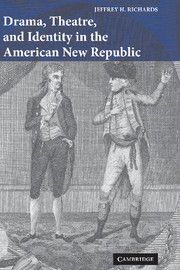Book contents
- Frontmatter
- Contents
- Acknowledgements
- Introduction
- 1 American identities and the transatlantic stage
- PART I Staging revolution at the margins of celebration
- PART II Coloring identities: race, religion, and the exotic
- 7 Susanna Rowson and the dramatized Muslim
- 8 James Nelson Barker and the stage American Native
- 9 American stage Irish in the early republic
- 10 Black theatre, white theatre, and the stage African
- PART III Theatre, culture, and reflected identity
- Notes
- Bibliography
- Index
10 - Black theatre, white theatre, and the stage African
Published online by Cambridge University Press: 22 September 2009
- Frontmatter
- Contents
- Acknowledgements
- Introduction
- 1 American identities and the transatlantic stage
- PART I Staging revolution at the margins of celebration
- PART II Coloring identities: race, religion, and the exotic
- 7 Susanna Rowson and the dramatized Muslim
- 8 James Nelson Barker and the stage American Native
- 9 American stage Irish in the early republic
- 10 Black theatre, white theatre, and the stage African
- PART III Theatre, culture, and reflected identity
- Notes
- Bibliography
- Index
Summary
On march 4, 1801, maria and harriet trumbull, the teenaged daughters of the Connecticut governor, were strolling about New York as part of their first extended visit to that city. They took in a variety of sights and experiences that day, including the inauguration celebration for Thomas Jefferson, which, as good Federalist girls, they were quick to deplore, but which, as country girls in the big city, they were sure to take in. At some point in their peregrinations, which included Chambers Street, where they stayed; Broadway, near the Park Theatre, where the inauguration procession traversed; and Vauxhall Gardens, just off Broadway, where the fireworks were launched, they noted in passing a curiosity to which they would have been unaccustomed in their home state: “they had a new play at the African Theatre.” What play? What theatre? On this, Maria's letter home is silent; after all, her parents held firmly to the antitheatrical sentiments of many in New England, despite the professional theatres in Boston and Hartford, and the girls were cautious when writing home in indicating their attendance at stage entertainments. But her one little clause tells us a great deal: Some time before March 4, 1801, a group of African Americans in New York City had banded together to put on plays, perhaps even “new” plays of their own devising, in a building that locals referred to as the “African Theatre.”
- Type
- Chapter
- Information
- Drama, Theatre, and Identity in the American New Republic , pp. 211 - 238Publisher: Cambridge University PressPrint publication year: 2005

